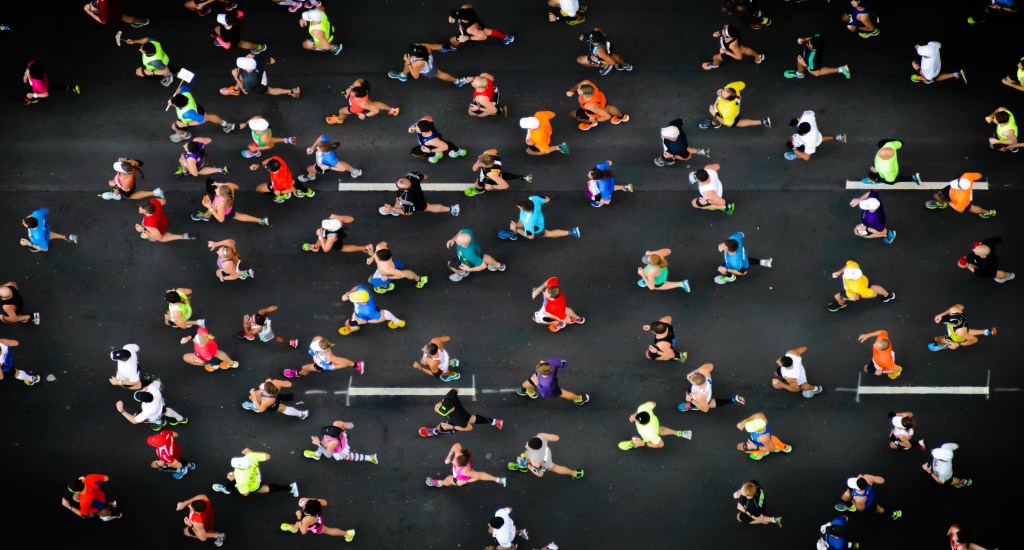Chasing the elusive two-hour marathon

Thousands of runners will test their mettle over 26.2 miles in the Boston Marathon on Monday, each striving for personal bests. Some will break records personal records, but it’s very unlikely any will achieve that elusive sub-two-hour marathon.
As several elite runners train separately to attempt just that feat—a feat that will require shaving nearly three minutes off the current world record—we spoke to David Nolan, associate clinical professor and director of the Sports Physical Therapy Residency program in the Bouvé College of Health Sciences, to find out what it will take to accomplish this lofty goal and whether we’re likely to see it for ourselves in a local race any time soon.
Nolan, who also sees patients at Massachusetts General Hospital’s sports physical therapy program and coordinates the physical therapy care at the finish line of the Boston Marathon, said conditions would need to be nearly perfect if anyone outside of those elite runners were to break two hours, and even then, it’s still likely years away.
Why hasn’t anyone broken a two-hour marathon yet?
There are a number of factors that play a role in the time, including the runner’s fitness and training, but also the course, the weather, and other competitors. If someone eventually breaks the two-hour mark, it will not be on his or her own but through a team approach, similar to a cyclist team that allows certain racers to draft and save energy during various stages.
Why is that two-hour mark such an important milestone?
Athletes strive to break records. Years ago, it was to break the four-minute mile pace. The marathon pace has been gradually getting faster each year. Many athletes are now within a few minutes of the two-hour mark. Over the course of a 26.2-mile race that may seem achievable— but it is not easy. The average pace for a marathon winner is around 4 minutes, 42 seconds per mile. The fastest mile time is 3 minutes, 43 seconds (but, remember, that is running one mile and you’re done). The mile pace to run a sub-two-hour marathon would need to be 4 minutes, 34 seconds for 26.2 miles. Look at the fastest sprinters and look at elite marathoners. They are built very differently. That fast mile pace is not sustainable over a long race. The body could not get enough oxygen to maintain that level.
How are elite runners’ bodies different from a standard runner’s body? Are these differences the result of genetics, training, or both?
Elite runners are very lean and efficient. Smaller size allows them not to have to work as hard to keep cool. The best runners are historically from East Africa and there are several theories that have been tossed around as to why Kenyans and Ethiopians are built so well for distance running.
How much of a role does one’s mental state have in achieving these sorts of record-breaking feats?
Mental toughness is necessary but that would not be enough. The training would be critical and there are also many factors outside athletes’ control that would need to line up to make it happen.
You mentioned other factors at play. What other variables—besides training and mental state—contribute to a runner’s performance? And in what way?
The weather—cooler temps mean it is easier to dissipate heat created from muscles working. A flat course with limited turns to allow for more efficiency. Limited headwind or, even better, a tailwind. The ability to draft behind other runners. Runners will do this, similar to race car drivers. Race cars draft to conserve fuel during a race and runners do the same. It is very rare to see a runner lead from start to finish. It is too tough to maintain the pace through the whole distance.
Take us through the race a bit—what will be happening in these runners’ bodies as they attempt to break the two-hour mark?
They are maximizing oxygen efficiency. It is all about managing oxygen supply and oxygen demand. This is the efficiency piece. Better VO2 max (a measure of the maximum volume of oxygen that an athlete can use) equals better running efficiency equals faster times. If one athlete is more efficient than another, his body can use less energy to go at the same pace as the other runner and he should be able to run longer or harder. The larger the muscles are, the more oxygen they need to fire—this is part of why elite runners are very lean.
Do you think we’ll ever see a sub-two-hour mile in, say, the Boston or New York marathons? That is, outside the realm of engineered, pristine conditions? If so, when? If not, why?
If you look at the fastest marathon times, most are from races in Europe rather than the U.S.
So, if someone were to break the two-hour mark, it would likely happen in Europe and in cooler weather. Some of the fastest times have been posted in temperatures around 40 degrees, and some actually believe just a bit cooler may be ideal for many runners as their bodies wouldn’t need to work as hard to stay cool. That means they conserve energy and remain efficient.
That said, I do not think that someone running a standard marathon without the advantages included in the Breaking2 team approach would be possible anytime soon.





